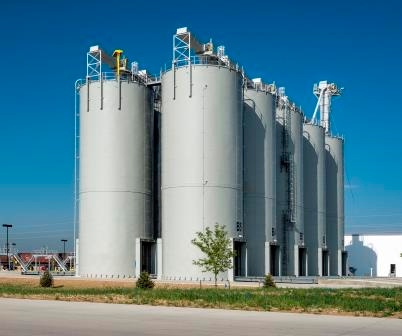Bolted Panel Silo Construction Offers Benefits That Ease Installation
March 20, 2014

The global increase in fuel exploration continues to drive the demand for frac sand and, along with it, the requirement for innovative storage solutions. Traditional construction methods including field-welded, jump form concrete, and slip form concrete are quickly becoming outdated as informed clients demonstrate a preference for flat-panel bolted silos. Bolted panel construction offers unique benefits that ease installation, reduce startup time, and increase safety on site – all while providing a superior quality storage asset.
Bolted panel manufacturing processes utilize state-of-the-art epoxy powder coating techniques, resulting in superior coverage to ensure long-term service in the field. Powder coating is electrostatically applied and thermally cured, all within a factory-controlled climate that equates to extremely low emissions for environmentally sound production. These benefits translate to the field, where no on-site blasting or coating is required, as opposed to field-welded construction that requires these procedures to be completed post-erection, subjecting the steel substrate to adverse weather and attracting contaminants to the uncured liquid-spray coatings. Field-applied coatings are costly in terms of time, materials, and adverse environmental effects.
Transportation, unloading, and storage/staging of materials during erection can present challenges in existing facilities where space is limited. Bolted-panel construction offers the smallest footprint requirement on site. Materials are shipped OTR via standard flat-bed semi, and arrive on pallets approximately 5x10 ft. Panels are presorted at the factory to correspond with erection sequence. In situations where space is extremely limited materials can be stored off-site, and quickly relocated for continuous assembly.
Facility start-up times are a critical component to achieving or maintaining market position within the frac sand industry. Bolted panel silo construction employs the use of hydraulic jacking equipment to expedite erection, keeping workers at grade level to promote safety and increase efficiency, thus reducing -- or in some cases eliminating -- the need to work at heights. This characteristic cannot be overstated. Worker safety is of the utmost importance in any industry, and especially in the energy/power sector where facility incidents can result in lost time, lost production, and costly fines. Bolted-panel construction methods speak for themselves in terms of safety, but just as important is the reduction in project completion timelines. As compared to traditional field-welded and concrete methods, bolted-panel construction can reduce completion on site by as much as 50 percent, resulting in faster facility start-up or expanded production.
Regardless of construction method, silos are generally categorized in three basic arrangements: fully skirted (the silo cylinder wall extends all the way to grade, containing the elevated hopper outlet cone within); short skirt (an abbreviated cylinder wall extending only a few feet below the hopper/sidewall connection point) which allows for placement on elevated structures: flat bottom (utilized in extremely large-volume applications in conjunction with mechanical or pneumatic reclaim equipment). Trans-load facilities typically consist of fully skirted silos with truck-drive-through arrangements. The TDT configuration requires less integration of auxiliary equipment and offers more streamlined operation.
Silo selection should be paramount in facility planning, drawing upon the support of a knowledgeable and experienced partner will greatly increase overall project success.
Steve Currence is VP sales, USA Tank (Goodman, MO). USA Tank manufacturers bolted steel silos and shop-welded silos for a wide range of dry storage applications, including frac sand, proppants, cement, fly-ash, limestone, minerals, and aggregates. For more information, visit www.usatanksales.com.
For related equipment reviews, articles, and news, visit our Storage Equipment Zone
Click here for information about the International Powder & Bulk Solids Conference & Exhibition
You May Also Like


